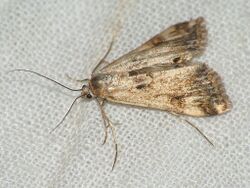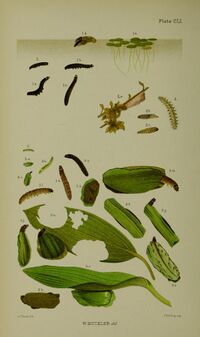Biology:Cataclysta lemnata
| Cataclysta lemnata | |
|---|---|

| |
| Scientific classification | |
| Kingdom: | Animalia
|
| Phylum: | |
| Class: | |
| Order: | |
| Family: | |
| Genus: | |
| Species: | C. lemnata
|
| Binomial name | |
| Cataclysta lemnata | |
| Synonyms | |
| |
Cataclysta lemnata, the small china-mark,[2] is a moth species of the family Crambidae. It is found in Europe (including Great Britain and Ireland),[2] Morocco and Iran.[3]
Adults of the species are sexually dimorphic.[3] The wingspan is 18–19 mm for males and 22–24 mm for females. The forewings are white. The costa, discal spot and a series of terminal spots are all fuscous. The hindwings are white with scattered pale fuscous scales.[4] Meyrick describes it- The forewings in male are whitish, with a yellowish-fuscous discal dot, traces of lines, and a pale brownish terminal streak; in female pale brownish, ochreous-mixed, with a darker discal spot, lines very indistinct, whitish, darker-edged, a whitish siibterminal streak. Hindwings are white; a dark fuscous discal dot; lines outlined with fuscous, sometimes nearly obsolete, first preceded by a yellow or fuscous spot in disc; subterminal and terminal ochreous lines enclosing a black fascia marked with four bluish-silvery dots. The larva is dark green or blackish; dorsal line black; head pale brown.[5]
The moth flies from May to August depending on the location.
Larvae are semiaquatic.[3] C. lemnata larvae have been recorded feeding on duckweed species (including Lemna species[3] and Spirodela polyrhiza[6]), as well as water ferns of the genus Azolla.[3] The species is known to pupate in cocoons[6] or shelters[3] built from plant material.
References
- ↑ Nuss, M. (2003–2011). "GlobIZ search". http://globiz.pyraloidea.org/Pages/Reports/TaxonReport.aspx.
- ↑ 2.0 2.1 "Small China-mark Cataclysta lemnata" (in en). http://www.ukmoths.org.uk/species/cataclysta-lemnata/.
- ↑ 3.0 3.1 3.2 3.3 3.4 3.5 Farahpour-Haghani, Atousa; Hassanpour, Mahdi; Alinia, Faramarz; Nouri-Ganbalani, Gadir; Razmjou, Jabraeil; Agassiz, David (20 January 2017). "Water ferns Azolla spp. (Azollaceae) as new host plants for the small China-mark moth, Cataclysta lemnata (Linnaeus, 1758) (Lepidoptera, Crambidae, Acentropinae)" (in en). Nota Lepidopterologica 40 (1): 1–13. doi:10.3897/nl.40.10062. ISSN 2367-5365.
- ↑ Agassiz, David J. L. (2012). "The Acentropinae (Lepidoptera: Pyraloidea: Crambidae) of Africa". Zootaxa 3494: 1–73. doi:10.11646/zootaxa.3494.1.1. ISBN 978-1-86977-986-3. http://www.mapress.com/zootaxa/2012/f/z03494p073f.pdf.
- ↑ Meyrick, E., 1895 A Handbook of British Lepidoptera MacMillan, London pdf
 This article incorporates text from this source, which is in the public domain. Keys and description
This article incorporates text from this source, which is in the public domain. Keys and description
- ↑ 6.0 6.1 Pabis, Krzysztof (2014). "Life cycle, host plants and abundance of caterpillars of the aquatic moth Cataclysta lemnata (Lepidoptera: Crambidae) in the post-glacial lake in central Poland". North-Western Journal of Zoology 10 (2): 441–444. ISSN 1843-5629. http://biozoojournals.ro/nwjz/content/v10n2/nwjz_142101_Pabis.pdf. Retrieved 30 January 2017.
External links
| Wikimedia Commons has media related to Cataclysta lemnata. |
- Waarneming.nl (in Dutch)
- Lepidoptera of Belgium
Wikidata ☰ Q2183333 entry
 |


